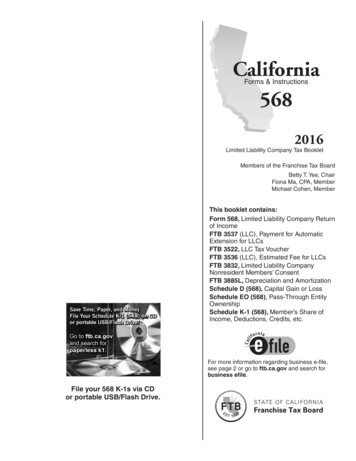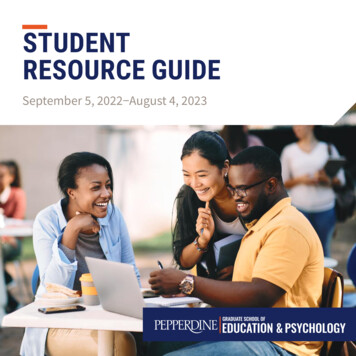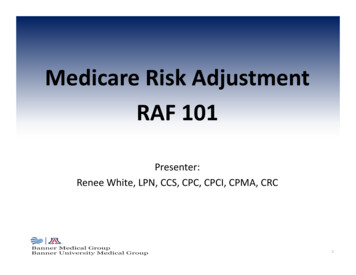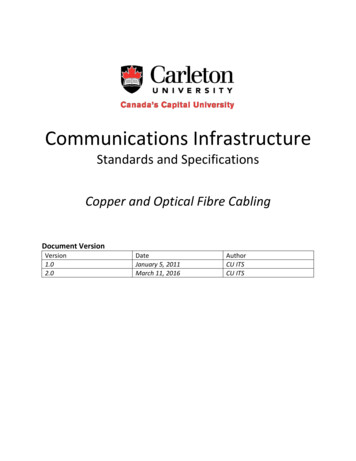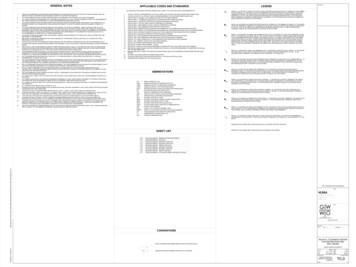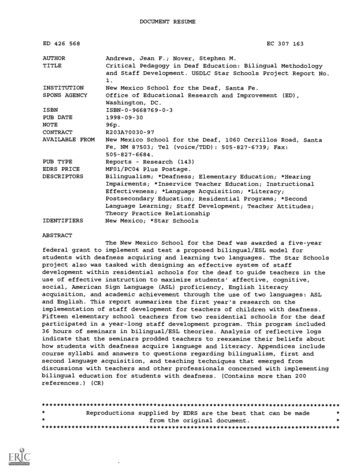
Transcription
DOCUMENT RESUMEED 426 568EC 307 163AUTHORTITLEAndrews, Jean F.; Nover, Stephen M.Critical Pedagogy in Deaf Education: Bilingual Methodologyand Staff Development. USDLC Star Schools Project Report No.INSTITUTIONSPONS AGENCYNew Mexico School for the Deaf, Santa Fe.Office of Educational Research and Improvement (ED),Washington, DC.ISBN-0-9668769-0-31998-09-301.ISBNPUB DATENOTECONTRACTAVAILABLE FROMPUB TYPEEDRS PRICEDESCRIPTORSIDENTIFIERS96p.R203A70030-97New Mexico School for the Deaf, 1060 Cerrillos Road, SantaFe, NM 87503; Tel (voice/TDD) : 505-827-6739; Fax:505-827-6684.ReportsResearch (143)MF01/PC04 Plus Postage.Bilingualism; *Deafness; Elementary Education; *HearingImpairments; *Inservice Teacher Education; InstructionalEffectiveness; *Language Acquisition; *Literacy;Postsecondary Education; Residential Programs; *SecondLanguage Learning; Staff Development; Teacher Attitudes;Theory Practice RelationshipNew Mexico; *Star SchoolsABSTRACTThe New Mexico School for the Deaf was awarded a five-yearfederal grant to implement and test a proposed bilingual/ESL model forstudents with deafness acquiring and learning two languages. The Star Schoolsproject also was tasked with designing an effective system of staffdevelopment within residential schools for the deaf to guide teachers in theuse of effective instruction to maximize students' affective, cognitive,social, American Sign Language (ASL) proficiency, English literacyacquisition, and academic achievement through the use of two languages: ASLand English. This report summarizes the first year's research on theimplementation of staff development for teachers of children with deafness.Fifteen elementary school teachers from two residential schools for the deafparticipated in a year-long staff development program. This program included36 hours of seminars in bilingual/ESL theories. Analysis of reflective logsindicate that the seminars prodded teachers to reexamine their beliefs abouthow students with deafness acquire language and literacy. Appendices includecourse syllabi and answers to questions regarding bilingualism, first andsecond language acquisition, and teaching techniques that emerged fromdiscussions with teachers and other professionals concerned with implementingbilingual education for students with deafness. (Contains more than 200references.) **********************************Reproductions supplied by EDRS are the best that can be madefrom the original ***************************************
rovementBEST COPY AVA1LA LEIU S DEPARTMENT OF EDUCATIONOffice of Educational Research and Improvement,TECATIONAL RESOURCES INFORMATIONCENTER (ERIC)his document has been reproduced asreceived from the person or organizationoriginating itO Minor changes have been made toimprove reproduction quality.Points of view or opinions stated in thisdocument do not necessarily representofficial OERI position or policy.cc)BItJiJLJflJLJgua Methudolog and staff evelopmentStephenrv ver Pr ject Direst r
USDLC Star Schools Project Report No. 1CRITICAL PEDAGOGYINDEAF EDUCATION:BILINGUAL METHODOLOGYANDSTAFF DEVELOPMENTStephen M. Nover, M.A.New Mexico School for the DeafandJean F. Andrews, Ph.D.Lamar UniversitySeptember 30, 1998 1998 by New Mexico School for the DeafAll rights reserved
The United Star Distance Learning Consortium, Inc. (USDLC) Star Schools Project ispleased to disseminate the information and perspectives contained in this report. Thefindings, conclusions, and opinions expressed herein are those of the authors and do notnecessarily reflect the views of USDLC or the New Mexico and Texas Schools for theDeaf.Copyright 1998byNew Mexico School for the DeafSanta Fe, New MexicoAll rights reserved.ISBN 0-9668769-0-3This report may be copied for limited distribution.To receive additional copies of this report, or for more information,please send correspondence to:Stephen M. Nover, Language Planner and Star Schools Project DirectorNew Mexico School for the Deaf1060 Cerrillos RoadSanta Fe, New Mexico 87503WIDD: (505) 827-6739FAX: (505) 827-6684E-Mail: snovergnmsd.k12.nm.usCover Design: Center for the Application of Information Technologies at Western IllinoisUniverstyFirst Printing, 2,000 CopiesPrinted in the United States of AmericaThis publication is based on work sponsored wholly or in part by the Office of EducationalResearch and Improvement, U.S. Department of Education, under Grant Number R203A7003097. The content of this publication does not necessarily reflect the views of OERI, theDepartment of Education, or any other agency of the U.S. government.4
TABLE OF CONTENTSPreface / vAcknowledgments / viiAbstract / ixIntroduction /1Historical Evolution of Deaf Education / 2Toward an Enhanced Model / 5a. Theoretical Framework: Bilingual/ESL Model 1 5b. Justification for Theoretical Model 1 6c. A Proposed Bilingual/ESL Model for Deaf Students 1 8Definition of Key Concepts / 9a. Bilingual Approach I 9b. ESL Approach 1 10Research Questions / 12a. Central Research Question / 12Data Collection and Analysis / 12a. Methods 1 12b. Selection of Participants 1 13Educational Research Team 1 13Administrators 1 14Teacher-Mentors 114Teacher / 14Parents and Residential Staff / 15The Students 1 15Procedures / 15a. Description of the Weekly Star Schools Seminars 1 15b. Teacher Exchange 1 16Main Findings / 16a. Research Question 1 / 16b. Research Question 2 1 17c. Research Question 3 1 18d. Research Question 4 1 18e. Analysis of Reflective Logs 1 18f. First Semester Teachers' Stories 1 19g. Second Semester Teachers' Stories 1 235iii
Discussion and Summary / 28Future Five-Year Plan / 28a. Student Evaluations 1 28b. Years One and Two 1 28Final Notes / 30Job Description for Star Schools Project Director / 32Job Description for Star Schools Assistant Project Director / 33Year One: Learning Log Goals and Readings / 34Protocol for the Year Two Syllabus for KSD / 39An Example of Reflective Log for Year Two for KSD / 44Protocol: Ethnographic Observation Form / 45Five-Year Plan / 46Language Learning and Language Teaching Issues / 48Language Distribution / 66Protocol for the Year Two Syllabus for NMSD and TSD / 67Appendix K: An Example of a Reflective Log for Year Two for NMSD/TSD / 71Appendix L: Assessment Instrument for Teacher Standards / 72Appendix A:Appendix B:Appendix C:Appendix D:Appendix E:Appendix F:Appendix G:Appendix H:Appendix I:Appendix J:References / 74List of FiguresDevelopmental Threshold Model: Level of Bilingualism Attained / 7Level of Interaction Among Students, Parents, and Professionals / 13Collapsed Means of Teacher Ratings of 18 Seminars / 174. ASL-English Translation Strategy / 625. Complexity of Language Use: Whole-to-Part Sequence / 641.2.3.List of Tables1.Language Use and Teaching Model for Deaf Students / 82. Background Characteristics of Teacher Participants / 153. Topics/Readings Ranked by Teachers / 174. Staff Development Plan (1997-2002) / 295.Bilingual Development Model / 51(6iv
PREFACEThe New Mexico School for the Deaf (NMSD), Santa Fe was awarded a five-yeargrant of 1.3 million through the Office of Educational Research and Improvement, U.S.Department of Education, Grant #R203A70030-97. The purpose of the Star Schoolsproject is to implement and test a proposed bilingual/ESL model for deaf students acquiringand learning two languages, American Sign Language (ASL) and English. In addition, theproject will design an effective system of staff development within deaf residential schoolsto guide teachers in the use of effective instruction to maximize deaf students' affective,cognitive, social, ASL proficiency, English literacy acquisition and academic achievementthrough the use of two languages: ASL and English. This report summarizes research onthe implementation of staff development for teachers of deaf children.Today, schools for deaf children and youth in the nation are in the process ofchange. Many, dissatisfied with traditional ways of teaching, have sought opportunities tore-examine current pedagogical practices. One change has been the adoption of ASLEnglish bilingual programs in deaf residential schools across the country. As yet,however, published standards, curriculum guidelines, and effective strategies available forteachers to use this approach are very limited. Further, many teachers for the deaf receivelittle or no training in the process of teaching deaf children bilingually (Strong, 1995).The challenge for the deaf education field is to implement and test a proposedbilingual/ESL model by focusing on how bilingual education can be effective for deafstudents. We have chosen the title Critical Pedagogy in Deaf Education: BilingualMethodology and Staff Development because our aim is to promote an approach to teachingand learning in which teachers and students reflect critically on classroom practice with theobjective of improving student learning. Using this approach, the Star Schools projectteachers "name" or recognize their beliefs about language learning and teaching, "reflect"critically on them, and then "act" on these beliefs in the classroom. In the same way,students are encouraged to practice and test the validity of the knowledge they acquire in theclassroom using their own contexts and experiences and thereby empowering themselvesby taking ownership of their education.The theoretical background for the project model is based on bilingual and Englishas a Second Language (ESL) principles, theories of first (L1) and second (L2) languageacquisition, Whole Language practices, ASL signacy development, and English literacydevelopment for deaf students. This model supports classroom instruction thatincorporates ASL, English, and Deaf culture. In this report, we describe and discuss thefindings of the first year of our five-year longitudinal project using this model.7
The Star Schools project model will ostensibly change, deepen, expand and berefined as data are collected and analyzed over the five-year grant period. Currently, itrepresents a starting point to investigate a question that has perplexed teachers for years:How can teachers utilize ASL academically while, at the same time, enhancing Englishliteracy?During Year One, 15 elementary school teachers from two residential schools forthe deaf in the Southwest (New Mexico School for the Deaf and Texas School for the Deaf[TSD]) participated in a year-long staff development program. This program included 36hours of seminars in bilingual/ESL theories. Specifically, it included theoreticalbackground and, where possible, applied research findings related to the new languageteaching practices being fostered. The teachers reflected on why an instructional change isbeing sought and what research evidence supports that change. For example, teachers readselected articles and books, responded to these readings in group seminars with otherteachers, wrote learning logs, and applied concepts gleaned from these experiences in theirclassrooms.Using action research and descriptive observation methods, we described thebilingual/ESL model, the staff development training sessions, and the teachers' responsesto the first year of training. We used teacher rating scales and case studies (or teacherstories) of how they applied these bilingual/ESL theories in the classroom to bring personaland professional insights to the learning process. We have shared and discussed teachers'responses using an approach that encourages them to analyze how their experiences in staffdevelopment can improve their practice, thereby improving student learning.This report concludes with a description of our staff development plans for YearTwo through Year Five. The appendices provide readers and practitioners with detailedcourse syllabi of the seminars for Year One and Year Two with data on teachers'distribution of the two languages in the classroom. Finally, we address 10 provocativequestions regarding bilingualism, first and second language acquisition, and teaching thathave emerged from our year-long discussions with teachers and other professionalsconcerned with implementing bilingual education for deaf students.8vi
ACKNOWLEDGEMENTSMuch of our work on the Star Schools project and in the schools for the deafwould not have been possible without the financial support of The Office of EducationalResearch and Improvement, U.S. Department of Education, and the efforts of schooladminstrators, participating teachers, an educational research team, an advisory board,and additional reviewers. They have provided thoughtful reactions and insightfulsuggestions to improve the quality of the Star Schools First Year Report. Although theyare not responsible for the contents of the report, their contributions are gratefullyacknowledged:School AdminstratorsNew Mexico Schools for the DeafMadan Vasishta, SuperintendentLynann Barbero, Director of InstructionTexas School for the DeafClaire Bugen, SuperintendentBetty Bounds, Interim AssistantSuperintendentNew Mexico School for the Deaf: Star Schools Project StaffStephen M. Nover Tommie BraselCarla Fenner Mindy BradfordParticipating TeachersTexas School for the DeafBetty Bounds, MentorJohnett Scogin, MentorCynthia Cunningham-PiperNew Mexico School for the DeafTommie Brasel, MentorKellie BarnesSally BunceTodd CzubekRobin GeeseyKathy GlyerLaurel MaradikMargie ProppSusan RevelsRosemary RomeroCathleen ShaverSharee DarceVicki EverhartCarilynne GayKim-Jennifer HamiltonAvonne Brooker-RutowskiChristina SicoliEducational Research TeamJean F. Andrews, Lamar UniversityBetty Bounds, Texas School/DeafTommie Brasel, New Mexico School/DeafSusan Dickinson, Douglas County, COCarla Fenner, New Mexico School/DeafNancy Eades, Kansas School/Deaf (KSD)Laurene Gallimore, W. Oregon UniversityStephen Nover, New Mexico School/DeafJohnette Scogin, Texas School/DeafDr. Pam Shaw, Kansas School/Deaf9vii
Advisory BoardCynthia Bailes, Gallaudet UniversityLawrence Fleischer, California StateUniversityJackie, Caballero, New Mexico ParentMargie Propp, New Mexico SchoolTeacherSandra Fradd, University of MiamiRichard Ruiz, University of ArizonaBetty Rewolinski, Texas ParentKim-Jennifer Hamilton, Texas SchoolTeacherAdditional Reviewers for Star Schools First Year ReportGlenn Anderson,University of ArkansasDavid Martin,Gallaudet UniversityKathee Christensen,San Diego State UniversityMary Martone,New Mexico School for the DeafOscar Cohen,Lexington School for the DeafSusan Mather,Gallaudet UniveristyJane Kelleher Fernandes,Gallaudet UniversityBill McCrone,Gallaudet UniversityJoseph E. Fischgrund,Pennsylvania School for the DeafDonald Moores,Gallaudet UniversityJoan M. Forney,Illinois School for the DeafJudith Mounty,Gallaudet UniversityJaney Greenwald,Santa Fe, New MexicoPeter V. Paul,The Ohio State UniversityRobert Hoffmesiter,Boston UniversityRoslyn Rosen,Gallaudet UniversityHarold Johnson,Kent State UniversityNadeen T. Ruiz,California State University,Sacramento, CAFreeman King,Utah State UniversityDavid Stewart,Michigan State UniversityMarlon Kuntze,Stanford UnversityMichael Strong,Univeristy of California, San FranciscoEddy Laird,Lamar UniversitySteve Witchey,Eastern North Carolina School for theDeaf10viii
AbstractThis is the first year of a five-year longitudinal study designed to implement and testa proposed bilingual/English-as-a-second language (ESL) model for deaf children thataddresses affective, cognitive, social, ASL proficiency, English literacy and academicissues through the use of two languages: American Sign Language (ASL) and English.During Year One (1997-1998), 15 teachers from two residential schools for the deaf whoworked with 90 deaf children at the elementary grade levels (Kindergarten through 5thgrade) participated in year-long staff development training. Training included 36 hours ofseminars in bilingual/ESL theories, theories of first- and second- language acquisition,Whole Language, and theories of language and literacy development. Teachers readselected articles, responded to these readings in group seminars with other teachers, wrotelearning logs, and then applied these concepts in the classroom. Using action researchtechniques, we describe the bilingual/ESL model, the staff development training, and theteachers' responses in Year One. We use teacher rating scales and case studies (or teacherstories) to show how teachers grew in their understanding of second-language-acquisitiontheories and how they applied those theories in the classroom. We conclude with adescription of our plan for Years Two through Five. Appendices contain data related to ourteachers' responses to the training.11ix
IntroductionIn my preparation as a teacher, no one ever told me about contradictions ineducation. No one ever told me about change in education. However, I amlearning that contradictions and change are fundamental for criticallyteaching and learning in the 21st century (Wink, 1997).Critical pedagogy is an approach to education that emphasizes the importance of aninteractive learning environment in which learners are encouraged to acquire knowledgeand confirm its validity in the context of their experience. While this is a general approachto education, it is especially valuable for students whose backgrounds, histories, andcultures tend to conflict with those of the larger society; in this circumstance, the results areoften domination, paternalization, and oppression of the poorer, marginalized, and lesspowerful groups. Critical pedagogy requires that the starting point for the education ofchildren be their own authentic experiences in the context of their culture. The expectationis that these students will develop critical thinking skills about their schools, their culture,and their learning. .Teachers, along with students, explore their environment throughdialog, reflective thinking, and action.Joan Wink (1997), in her book, Critical Pedagogy: Notes from the Real World,applied this notion of critical pedagogy to teaching in her classroom. She recognized thatchange is fundamental to this philosophy. According to Wink, not every child fits everylearning theory. Teachers must continually question previous beliefs and assumptions andrespond to the real child in the classroom. Critical pedagogy, she said, is a process whereteachers name their beliefs, reflect critically on them, and then act on them. This involvesproblem posing, reflective thinking, knowledge gathering, and collaborative decisionmaking where teachers, with their students, learn new information and explore ways ofusing this knowledge (e.g., Carter, 1993; Coye, Humphries, & Martin, 1978; Joyce &Showers, 1995; Kutner, 1992; Murry, 1996; Ovando & Collier, 1998).The orientation of this study is critical; it assumes that deaf students have a distinctculture (Deaf Culture) with identifiable values and traditions and a language (ASL) with along history of development (e.g., Andersson, 1994; Barnum, 1984; Bienvenu, 1992;Lucas, 1996; Padden & Humphries, 1988; Kannapell, 1974, 1978; Padden & Ramsey,1993; Parasnis, 1996; Stokoe, 1980; Wilcox, 1989). These students are part of a culturalminority group that has been marginalized in U.S. society and schools; their language,ASL, has been almost completely excluded from the education of deaf students(Christensen, 1993; Kannapell, 1974, 1978, 1993; Ruiz, 1993/1994; Woodward, 1978,1982). In this context, how does one make education meaningful to deaf students in a way12
2that allows them to question critically rather than accept passively values that interfere withthe development of their full potential? Further, how can we facilitate teachers questioningof traditional beliefs about how languages are acquired and how language is taught?Educational traditionalists have essentially ignored these questions by focusing primarily onthe language and culture of the Hearing world while avoiding the issues raised by theinclusion of American Sign Language and Deaf culture in instructional settings (e.g., theinclusion movement; Boese, 1975; Branson & Miller, 1995; Evans, 1998; Ewoldt, 199394; Lane, 1992; Lane, Hoffmeister, and Bahan, 1996; Nover, 1995; Reagan, 1994; Rinnie,1995; Woodward, 1978, 1982).Historical Evolution of Deaf EducationHistorically, teachers' beliefs and assumptions about language development anddeaf children have profoundly influenced how they taught. For example, from 1900 to1950, many believed that with repetitious training, deaf children would develop Englishthrough speech training. From the 1950s to the 1970s, behaviorist theories dominated.These theories were based on the belief that if children were exposed to both speech andsigning, they would develop English skills from imitating teachers and parents. In the late1960s, sign language was recognized by linguists as a natural language (Stokoe, 1960).Educators began using signs in the classroom with the philosophy of total communication.The term total communication (TC) was first coined by a deaf man, Roy K. Holcomb, in1967 (Evans, 1982; Garretson, 1976). Holcomb proposed that TC consists of auditorytraining, speech, speech reading, finger-spelling, and the language of signs (ASL); heemphasized the importance of using all means of communication with deaf children at theearliest possible age. While TC did break oralism's strong grip on schools and led to there-introduction of ASL in classroom and homes, TC did not lead to expected gains inacademic achievement for deaf students (Barnum, 1984; Charrow, 1975; Johnson, Liddel& Erting, 1989; Stewart, 1992; Woodward, 1978, 1982). For many, total communicationevolved into artificially constructed manual systems which dominated most classrooms(Hoffmeister, 1990; Evans, 1982; Moores, 1996; Nover, 1995b; Reagan, 1995; Stewart,1992; Woodward, 1978, 1982). From the 1970s to 1980s, Chomsky's (1965, 1967,1968) theories of transformational grammar filtered into the field, and teachers began to seelanguage as having a different levels of structure and meaning. Also during this time,artificially constructed manual systems of English became popular. Schools throughout thecountry mandated the use of these systems in the belief that if deaf children were exposedto them, they would develop reading and writing skills (Reagan, 1995; Ramsey, 1989;13
3Stewart, 1992). Now, in the 1990s, the bilingual-bicultural, Whole Language,' andemergent literacy approaches of teaching deaf children language and literacy have gainedrecognition in schools (e.g., Ewoldt, 1993-94; Fernandes, 1997; La Sasso & Metzger,1998; Liddell & Johnson, 1992; Livingston, 1997; Paul, 1998; Prinz & Strong, 1998;Strong, 1988b, 1995; Walworth, Moores & O'Rourke, 1992).For many teachers, the bilingual-bicultural approach has meant the use of ASL asthe language of instruction, teaching English as a second language, and offering speechinstruction as an elective. Also included in this approach is an emphasis on providingstudents with knowledge about Deaf culture. Schools for deaf children such as those inIndiana, California, Massachusetts, Texas, New Mexico, and Maryland have endorsed thisapproach in the U.S. (Ewoldt, 1993-94; Livingston, 1997; Nover, 1995b; Prinz & Strong,1998; Strong, 1988b, 1995). Schools in France (Bouvet, 1990), Denmark, and Sweden(Mahshie, 1995) are also using a bilingual approach. Despite acceptance of the bilingualapproach, there are no standards, and limited publications of curricula or guidelines areavailable for using it (Coke ly, 1978; Stewart, 1992; Strong, 1995). Therefore, a strongerresearch base is needed. As far as we know, many teachers receive little or no training inbilingual/ESL approaches (Coke ly, 1978; Gallimore, 1993; Woodward, 1978).In our view, bilingual education involves more than using ASL to teach English. Itis not enough to present academic concepts in ASL and expect deaf students to use theseconcepts to build English skills. Students need explicit instruction about how ASLstructures work as well as how English grammar works via reading and writing lessons(Hoffmeister, in press; Padden, in press; Padden & Ramsey, 1996, 1998; Stewart, 1992).Initially, it may take two languages (both ASL and English) for deaf students to buildEnglish skills. Teachers, therefore, need to possess a knowledge of and fluency in bothASL and English as well as an adequate understanding of principles of second-languageacquisition, bilingual methodologies and language acquisition, and learning strategiesuniquely tailored to deaf students (Prinz & Strong, 1998; Strong, 1988b).The bilingual approach also involves notions of cultural congruence. This meansteachers can develop approaches to teaching and can organize their classrooms in ways thatare compatible with the students' background and language (e.g., Lee & Fradd, 1998;Philips, 1983; Tharp, 1994). Like the students who do not have an English language' The "whole language" approach emphasizes the whole connected text with alphabetic and word learningassumed to occur implicitly. In contrast, the phonics approach emphasizes sound-spelling patterns like the"direct code" approach which focuses on letter-sound correspondences. Practitioners vary on how theyimplement these approaches, some to a greater (or lesser) degree than others. Today, teachers use acombination of "top-down" and "bottom-up" approaches, depending on the specific reading skills to betaught (see; Altwerger & Flores, 1996; Draper & Smith, 1996; Harman, 1996).14
4background and, consequently, need teachers who are sensitive to their culture andbackground, deaf children will benefit from instruction that is sensitive to their visual waysof learning as well as Deaf culture (Christensen, 1993; Humphries, 1993; Lucas, 1996,1998; Mather, 1989).Further, the bilingual approach involves the understanding and awareness of Deafcultural issues such as oppression, audism, and hearization. Lane (1992) provided an indepth analysis of oppression, which is implicitly present in deaf education. For example,he described how the underlying mechanism of traditional educators and professionalspromotes, reproduces, and maintains dominant-subordinate relationships within theframework of deaf education. In other words, these mechanisms legitimize, disseminate,promote, reproduce, and maintain auditory-based doctrines through the established politicaland educational practices in deaf education. Similarly, another form of oppression is"audism," which was first coined by Tom Humphries who described the devaluation of theviews and experiences of deaf people by hearing professionals (Lane, 1992; Nover, 1993,1995b). Further, it is defined as any attitude, belief, behavior, or institutional arrangementthat tends to favor the hearing majority group over the Deaf minority group, the Deafcommunity (e.g., Lane, 1992; Nover, 1993, 1995; Nover & Ruiz, 1994; Vernon &Makowsky, 1969; Vernon, 1990; Vernon & Andrews, 1990; Woodward, 1978, 1982). Inaddition to these forms of oppression, hearization was coined by Nover (1995b) whodefined it as a process whereby deaf children are forced to imitate and then are directed torepeat the unnatural language behaviors, preferences, expectations, values, perspectives,ethos, and characteristics of an auditory-based culture through spoken or an artificialmanual code of English. This process thus severely constrains2 deaf children's acquisitionof a natural language, ASL, and prevents them from fully understanding their own Deafculture. Another form of oppression is the authoritarian personality, which is oftenoverlooked in school discussions (Vernon & Makowsky, 1969; Vernon, 1990). Vernondescribed as authoritanian those personality traits that sought to dominate, control, orpaternalize deaf persons. Such individuals have high levels of repressed anger and hostilitywhich they direct at deaf persons, minorities, or other persons who they consider different.These negative attitudes toward the deaf can affect deaf children's self-concepts.Several studies citing the effects of negative attitudes have been conducted by Keefe(1982), Rinnie (1995), and Wrigley (1992). Keefe investigated the hidden curriculum ofpreschool programs for the deaf in Massachusetts. One significant finding revealed that thehidden curriculum does have significant negative effects on the self-image and development2 Critical period will have been long passed when deaf children are exposed to ASL.15
5of deaf children. Rinnie described the attitudes of hearing professionals and educators andstated that ASL was prized by deaf people and less respected by many hearing people indeaf education. Wrigley provided an in-depth analysis of how the pathological views ofhearing people shaped the politics of Deaf identity. He reported that they repeatedlydevalued the visual modality of ASL used by deaf people.Currently, many hearing professionals working with deaf students continue to holdthese negative attitudes (e.g., Bellugi, 1975; Glickman, 1993; Hoffmeister, 1996;Kannapell, 1978; Sussman, 1975; Woodward, 1978, 1982). Using the notion of "criticalpedagogy" within a bilingual approach, these issues need to be confronted to allow teachersto examine traditional ways of teaching deaf children related to language learning (ASL andEnglish) and to explore strategies that result in a more effective approach (e.g., Coye,Humphries, & Martin, 1978).Toward an Enhanced ModelThe purpose of this study is to examine the implementation of a more effectivemodel for deaf education using a bilingual/ESL approach. Teachers in our study examinedcurrent theories in bilingual/ESL approaches, first- and second-language acquisition,Whole Language, and English literacy development and their application to languagelearning and language teaching of deaf children. We then asked teachers to rate thesetheories and create language teaching strategies for use with deaf students in theirclassrooms.3 Throug
Santa Fe, New Mexico 87503 WIDD: (505) 827-6739 FAX: (505) 827-6684 E-Mail: snovergnmsd.k12.nm.us. Cover Design: Center for the Application of Information Technologies at Western Illinois Universty. First Printing, 2,000 Copies Printed in the United States of America. This publication is based on work sponsored wholly or in part by the Office .
